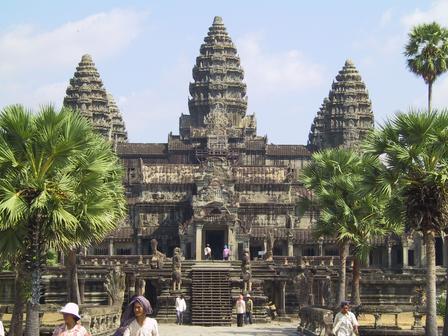Architecture of Cambodia
|
|
| Contents |
Features
Apsarasdevatakdei01.jpg
Apsaras and devatas
Apsaras, or celestial dancing girls, originated in Indian mythology, but their widespread decorative use was a Khmer innovation. The term is commonly used to cover not only dancers but any heavenly nymphs, although the latter are technically devatas rather than apsaras. True apsaras are found in the Halls of Dancers and are seen in bas-reliefs flying above sacred scenes, while the largest population of devatas (around 2000) is at Angkor Wat, where they appear individually or in groups.
Blind doors and windows
Colonettesbanteaysrei.JPG
Central sanctuary
The central sanctuary was home to the temple's primary deity, that to whom the site was dedicated. The god or Buddha, as appropriate, was represented by a statue (or in the case of Shiva, sometimes by a linga). As the temple was not place for worship by the population at large, the sanctuary needed only to be large enough to hold this statue; it was never more than a few metres across. Its importance was instead conveyed by the height of the tower above it, by its location at the centre of the temple (both indicative of the sanctuary's representing Mount Meru) and by the greater amount of decoration on its walls.
Colonettes
Colonettes were used as decoration on either side of doorways.
Corbelling
Corbelangkorthomsouth.JPG
Enclosures
Khmer temples were typically enclosed by a concentric series of walls, with the central sanctuary in the middle: this arrangement represented the mountain ranges surrounding Mount Meru. The enclosures are numbered from the centre outwards. Galleries frequently ran along them, while passage through them was through gopuras at the cardinal points.
Gallery
Cruciformgalleryangkorwat.JPG
Gopura
Gopurataprohm.JPG
Hall of Dancers
The Hall of Dancers is a structure found at Ta Prohm, Preah Khan, Banteay Kdei and Banteay Chhmar. In each case it is a rectangular building elongated along the temple's east axis; and divided into four courtyards by galleries. The roofs were made of perishable materials and have disappeared. The pillars of the galleries are decorated with dancing apsaras, hence the presumption that the buildings were used for dancing.
House of Fire
The House of Fire, found only in temples of Javarman VII's reign, is enigmatic. 121 are known, all along the highways in and out of Angkor; it seems therefore to have been a resting point of some kind, either for travellers or (as the name suggests) for the sacred flame used in religious ceremonies. It has thick walls , a tower at the west end and south-facing windows. Examples include those at Preah Khan, Ta Prohm and Banteay Chhmar.
Libraryangkorwat.JPG
Library
The library is one of the most common features of Khmer temple architecture, but it is still not certain what they were used for. Most likely they were shrines rather than actual libraries. Free-standing buildings, they were normally placed in pairs on either side of the entrance to an enclosure, opening to the west.
Lintels and pediments
Pedlintelsrei.JPG
Nagas
Ankor_Tom_in_Cambodia_001.JPG
Quincunx
Quincunxlingakbalspean01.JPG
Srahs and barays
Srahs and barays were reservoirs, generally created by excavation and embankment respectively. The two largest at Angkor were the West Baray and the East Baray, located on either side of Angkor Thom. Temples were built in the middle of both of these (the West and East Mebons), while Neak Pean was built at the centre of Preah Khan's Jayatataka. It is not clear to what extent the significance of the reservoirs was religious, agricultural, or a combination of the two.
Temple mountain
Temple mountains took the form of representations of Mount Meru, home of the gods in Hindu mythology. The temples were built in a series of tiers, each shorter than the last to create an illusion of greater height. The first known example was Ak Yum, although very little of that structure now remains; others at Angkor were Bakheng, Bakong, Bapuon, Pre Rup, Ta Keo and most notably Angkor Wat. Each of these was in turn the state temple, and thus the religious centre of the whole empire.
Reference
- Freeman, Michael and Jacques, Claude. Ancient Angkor. River Books, 1999. ISBN 0834804263.

